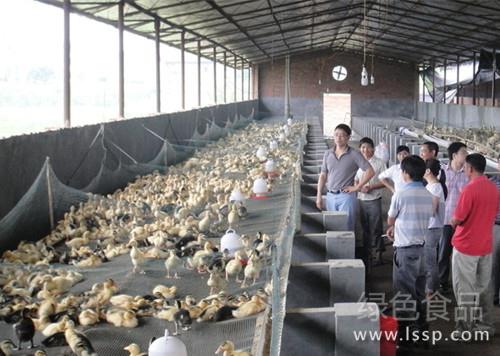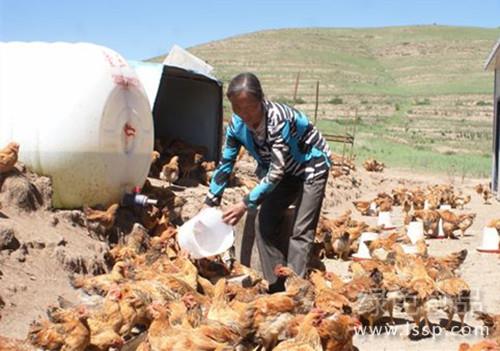The key points of management techniques for keeping ducks in captivity can save labor.

Duck breeding in captivity
1. Clustering and density:
Young ducks can be kept in captivity, but each flock should be about 500 ducks. When grouping, try to have the same age, size, variety and sex as far as possible.
The feeding density varies with the age, season and temperature of ducks, generally according to this standard: 10 weeks of age, 12 birds per square meter; 11, 20 weeks of age, 12 ducks per square meter; more ducks in winter and fewer in summer. Ducks grow faster and have less density, while ducks grow slowly and have higher density.
Second, feed for captive ducks:
Captive farming is different from grazing in that it basically does not have any wild feed and relies entirely on artificial feeding. Therefore, the nutrition needed for the growing period of young ducks, especially for long bones and feathers, should be satisfied, feed should be diversified as far as possible, the balance of energy and protein should be maintained, so that there are sufficient sources of sulfur amino acids, vitamins and inorganic salts.
During the breeding period, the dietary protein level of young ducks should not be too high, and the calcium content should be suitable. For example, the normal laying age of Shaoxing duck is 130 ~ 150 days, and the standard starting weight is 1400-1500g. If the body weight is more than 1500 g, it will be too hypertrophic, which will affect the timely production. It should be slightly restricted and fed with more roughage. For ducks with poor development and light weight, the average daily feed weight of each duck is about 150 grams, plus a small amount of fresh animal feed to promote growth.
The feed for young ducks is made of mixed powder instead of single raw materials such as corn, rice, wheat and so on. Before feeding, add proper amount of water and mix it into wet material and feed it raw. Feed only 3 or 4 times a day, and the interval between each feeding should be the same as possible to avoid uneven hunger and satiety of ducks.
3. Key points of management:
(1) properly strengthen exercise, promote bone and muscle development, prevent overweight, drive ducks regularly in the shed for 5-10 minutes every day, and exercise 2-4 times a day. If there is a suitable grazing ground near the duck house, short-distance grazing activities can be carried out regularly.
(2) more contact with ducks to improve the courage of ducks and prevent panic. Young ducks are timid, especially for egg breeds. In their youth, young ducks should make use of feeding, water feeding, grass change and other opportunities to get in touch with ducks. For example, when feeding, people stand by to observe the feeding situation and let ducks walk around themselves. when "delicate ducks" lie still beside them, they can touch them with their hands. over time, ducks are not afraid of people. Ducks are timid and easy to panic, causing serious losses.
(3) Lighting all night and low light in the house. Young ducks do not need strong lighting during the breeding period. The standard light time per day is 8: 10 hours, which is not increased before the start of production. For example, using natural light, autumn duck is the most suitable. However, in order to facilitate the duck to drink at night, in case of alarm caused by the movement of mice or birds and animals, it should be illuminated with low light all night. If you can light a 1.5 watt bulb in a 30 square meter duck house, you should immediately light a kerosene lamp with a glass cover in case of a power outage. Ducks illuminated by low light all night for a long time often cause serious alarm in a dark environment, causing quite a lot of casualties.
(4) strengthen the prevention of infectious diseases. Young ducks have two main infectious diseases: duck plague and cholera. Both diseases are now preventable with vaccines. Immunization arrangement: avian cholera vaccine was injected once at the age of 60-70 days. The avian cholera vaccine was injected once before and after 100 days old, and the duck plague attenuated vaccine was injected once at the age of 70-80 days. Egg ducks raised for only one year can be injected once, and egg ducks that have been raised for more than two years should be injected again every other year. Duck plague and cholera vaccination should be completed before the start of laying. After reaching the peak of egg production, avoid injections as far as possible so as not to affect egg production.
(5) to establish a stable work and rest system and a stable living environment for captive ducks, it is necessary to make regular work and rest and operation rules according to the duck's living habits. After the formation of the work and rest system, try to keep it stable and not change it often.
- Prev

Prevention and treatment of mucinous enteritis in rabbits with abdominal enlargement and drooling fecal tape
Prevention and treatment of mucinous enteritis in rabbits with abdominal enlargement and drooling fecal tape
- Next

Drink more water in summer and many laying hens have peak drinking water requirements in winter.
Drink more water in summer and many laying hens have peak drinking water requirements in winter.
Related
- On the eggshell is a badge full of pride. British Poultry Egg Market and Consumer observation
- British study: 72% of Britons are willing to buy native eggs raised by insects
- Guidelines for friendly egg production revised the increase of space in chicken sheds can not be forced to change feathers and lay eggs.
- Risk of delay in customs clearance Australia suspends lobster exports to China
- Pig semen-the Vector of virus Transmission (4)
- Pig semen-the Vector of virus Transmission (3)
- Five common causes of difficult control of classical swine fever in clinic and their countermeasures
- Foot-and-mouth disease is the most effective way to prevent it!
- PED is the number one killer of piglets and has to be guarded against in autumn and winter.
- What is "yellow fat pig"? Have you ever heard the pig collector talk about "yellow fat pig"?

